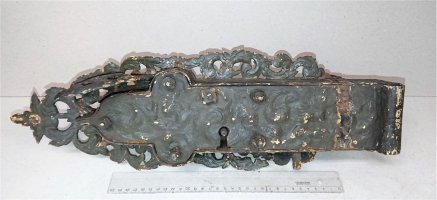Historical locking mechanisms and the lock from the Piarist church in Most
› Detail › Historical locking mechanisms and the lock from the Piarist church in MostExhibit of the month 3 / 2023
Historical locking mechanisms
Part of the old collection of the Most city museum was a set of more than four hundred pieces of metal artistic crafts from the Middle Ages and modern times. Mainly locks, keys, door and window handles, fittings, armchairs, candle holders, but also shackles or torture tools.
A large number of old locks and keys were purchased from Israel Schwarze, who was an antique dealer and junk dealer in Most. The museum was supplied especially in the early years of its existence (1888-1900). Since the 1870s, the city of Most experienced rapid development. New houses were springing up like mushrooms after rain, and older ones were modernized. The emphasis on higher security was manifested, among other things, by the massive replacement of old locks and locking mechanisms, which then ended up, among other places, in Schwarze's shop.
In only a few cases do we know where they come from. Unfortunately, this information is missing for most. However, we are certainly not far from the truth if we assume that they were mostly part of the doors of Most houses.
As part of the exhibit of the month, we now offer the most diverse selection of locks and keys. They illustrate well that they also succumbed to the fashion of the time, often being decorative and artistically crafted. At the same time, they had to flawlessly fulfill their practical function.
Lock from the Piarist church in Most
During the demolition of the old Most, some valuable artistic craft items were saved for the museum collections. One of them was this door lock (inv. no. HKP-00475). It was handed over to the museum in October 1972 by the "Technical Services Squad of Most," represented by engineer Burian. It was then recorded in the accession book along with other items (altar painting, sandstone weight from the tower clock, etc.) in 1973.
The so-called Piarist church (dedicated at different times to the Nativity of the Lord, St. Mary Magdalene, and the Seven Joys of the Virgin Mary) was originally built for the Magdalene sisters of Most. However, by the will of Emperor Joseph II, they were forced to leave Most in 1782, and the church was taken over by the Piarist order, which operated a famous gymnasium in Most. The city then took over the church from the Piarists (after 1872). The last to use it was the Orthodox Church (since 1959). At that time, the Baroque ceiling paintings were whitewashed. The church was demolished in 1977.
Text and photo: Dagmar Čechová
 en
en cs
cs de
de
